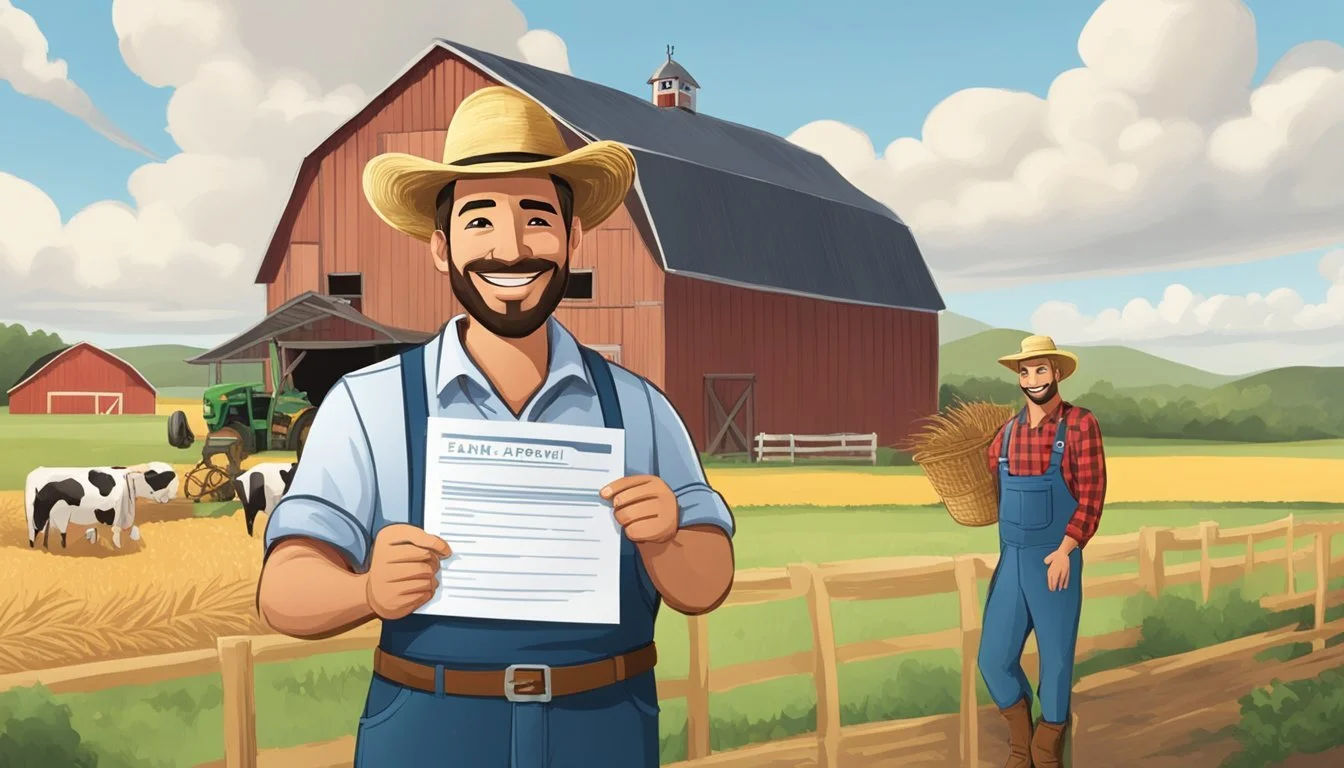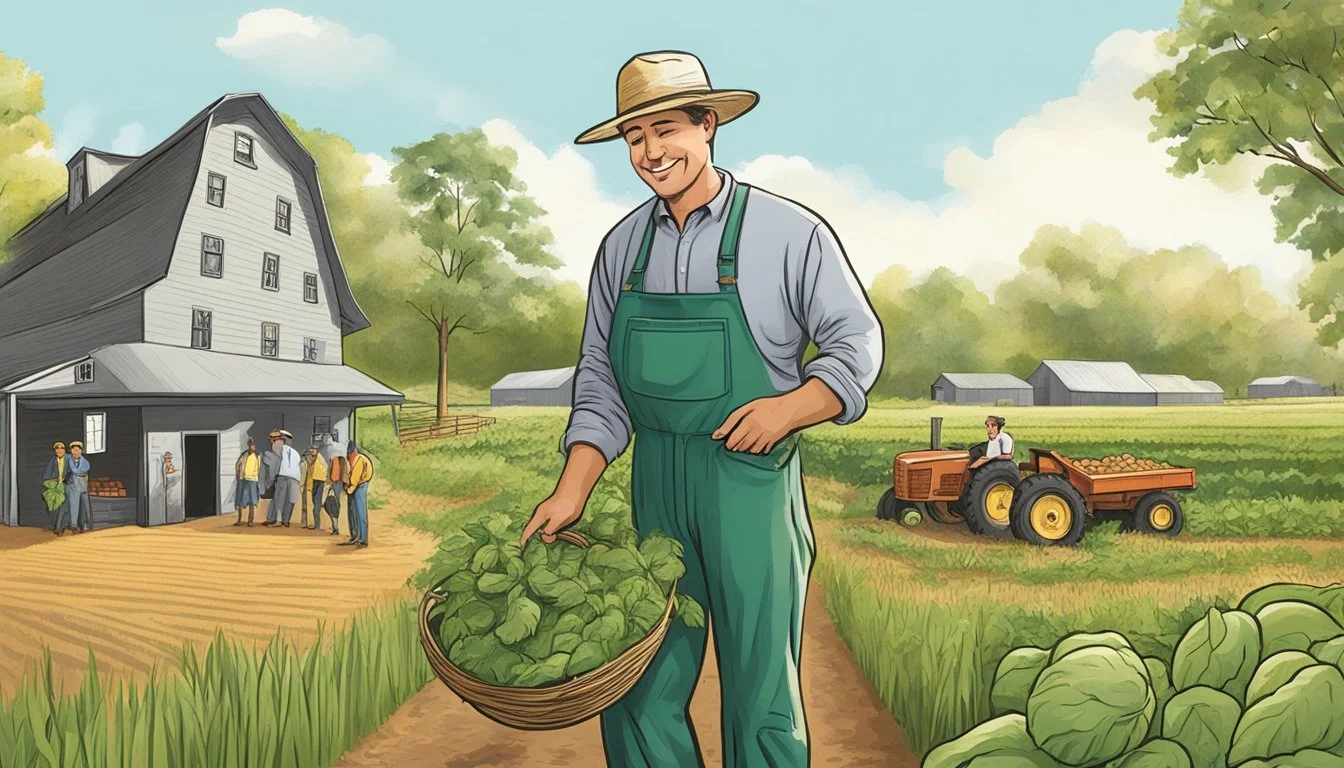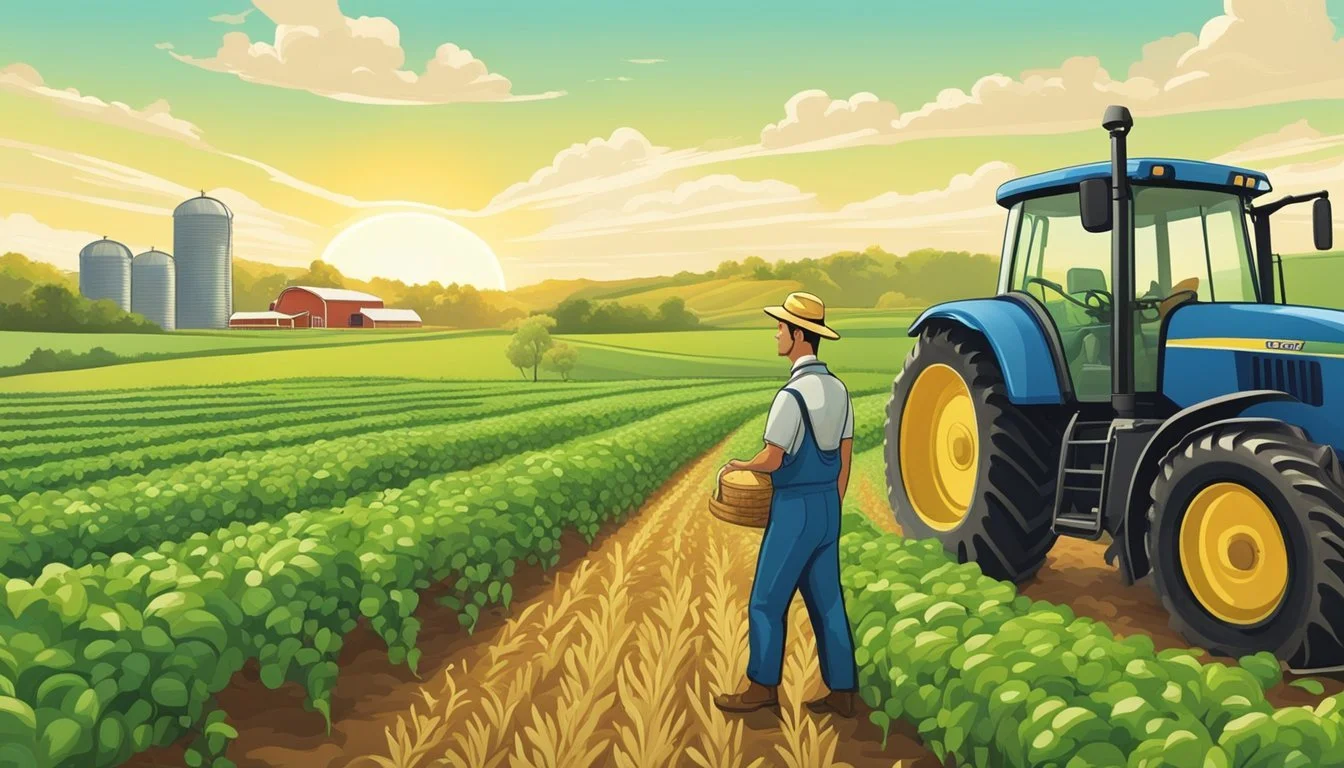Farm Loans in New York
Navigating Financial Options for Farmers
This Article is Part of Our Guide on Farm Loans for All 50 U.S. States
Farm loans in New York are integral to the state's agricultural economy, providing essential capital for the over 33,000 farms that dot its landscape. As a consistent contributor of more than $5 billion in annual sales, the agricultural sector relies on these loans for a range of purposes, from initiating and expanding operations to upgrading equipment and facilities. Various providers, such as the USDA Farm Service Agency and Farm Credit institutions, offer customized financing solutions to meet the diverse needs of New York's farming community.
These financial instruments often cater to specific farm-related activities like purchasing land, covering operational costs, and investing in sustainable practices to conserve soil and water resources. Given the fluctuating nature of factors such as milk prices and input costs, effective financial planning becomes crucial. Farm Credit East, for instance, offers insights through webinars discussing trends such as the outlook for the dairy industry in the Northeast, which in 2024 indicated a decline in milk prices offset by a decrease in feed and fuel costs.
In addition to private financial services, the USDA's Farm Service Agency administers congressionally authorized programs offering credit and commodity programs. The FSA emphasizes accessibility through its local county offices spread across the state. With Farm Ownership Loans, the FSA facilitates farm acquisition and the enhancement of agricultural infrastructure, while protecting environmental resources, showcasing the multifaceted role of farm loans in supporting New York's agricultural vitality.
Overview of Farm Loans in New York
In New York, various programs offer financial support tailored for the agricultural sector, encompassing loans for conservation, disaster assistance, and farm expansion, all designed to strengthen farm operations and land ownership.
Types of Farm Loans Available
Operating Loans: Aimed at day-to-day farming business expenses.
Farm Ownership Loans: For purchasing land, constructing buildings, and other real estate investments.
USDA Programs: Includes initiatives like price support commodities and disaster relief funding.
Key Financial Institutions for Farm Loans
USDA Farm Service Agency: A primary source for federal loans, offering a range of financial products for agricultural support.
Local Lenders: Institutions like Conterra Ag Capital specialize in farm real estate-backed loans.
New York State Programs: Grants and loans targeting beginning and socially disadvantaged farmers to bolster their entry and expansion in the market.
Regional Banks and Creditators: These lenders, including farm credit services, provide customized financing solutions for the diverse needs of New York's agribusinesses.
Eligibility and Application Process
In New York, securing a farm loan through the USDA Farm Service Agency (FSA) begins with understanding the detailed eligibility criteria and navigating the application process with precision.
Determining Loan Eligibility
Eligibility for FSA farm loans is strictly outlined to ensure that funds are distributed to qualified individuals and entities. Beginning farmers, those who have operated a farm for not more than 10 years, are often prioritized to encourage new entrants into farming. To be eligible, applicants must meet several criteria:
Be a U.S. citizen or permanent resident
Have a satisfactory credit history
Demonstrate the ability to repay the loan
Cannot be delinquent on federal debt
FSA provides a specific fact sheet and handbook to guide applicants through eligibility requirements, available at local USDA Service Centers and online.
How to Apply for Farm Loans
The application process for FSA farm loans involves several steps:
Develop a Business Plan: A comprehensive plan detailing the farm's goals and financial projections.
Complete Required Forms: Including the loan application (Form FSA-2001) and other supporting documents.
Here is a straightforward list of the process:
Visit the local FSA office or use the FSA's online portal.
Consult with an FSA loan officer.
Gather necessary documentation, such as proof of identity, financial history, and collateral.
Submit the loan application along with the required forms.
Interest rates for FSA farm loans are determined by the government and may vary based on the loan type and borrower's qualifications. Additionally, potential borrowers should be aware of any closing costs that may apply.
By following these specific procedures and understanding the associated costs, applicants can confidently navigate the FSA farm loan application process.
Loans for Operating Expenses
In New York, farm operating expenses can be covered by a variety of loans tailored to the agricultural sector. These loans are critical in sustaining farm operations, from buying seed to covering daily expenses.
Operating Loan Details
Farm operating loans are specifically designed to meet the day-to-day operational needs of farms. They can be used for purchasing livestock, seed, equipment, and for other costs associated with running a farm. In New York, the USDA's Farm Service Agency (FSA) offers Direct Operating Loans with a maximum amount of $400,000. These loans are government-funded and serviced locally, ensuring that farmers have access to necessary resources to maintain productive operations.
Microloans and Their Uses
Microloans serve as a more accessible financial product for small farmers or those just starting out, allowing them to borrow up to $50,000. These loans can be utilized to:
Purchase farm equipment
Invest in seed and other planting materials
Cover the operational costs such as feed, fertilizer, and other farm inputs
Microloans aim to simplify the lending process with less paperwork and a more expedited approval process. They play a significant role in aiding farmers with smaller operations or urban farms.
Emergency and Youth Loans
Two specialized loan types cater to unique circumstances on farms: emergency loans and youth loans. Emergency loans are available for farmers who have incurred losses due to natural disasters, ensuring they can recover and continue their operations. The youth loans target younger individuals, specifically those involved in 4-H clubs or FFA, providing them funds to undertake agricultural projects.
Emergency loans: Assists with physical and production losses
Youth loans: For young farmers associated with 4-H clubs or FFA, with a maximum loan amount of $5,000
Both emergency and youth loans are instrumental in supporting the resilience and future of the farming community in New York.
Farm Ownership Support
Farm Ownership Loans offer vital financial backing for farmers and ranchers aiming to purchase, expand, or maintain their farmland. These loans provide an opportunity for growth and sustainability in the agricultural sector, ensuring that essential farming operations can continue to flourish.
Ownership Loan Information
USDA's Farm Service Agency (FSA) provides Farm Ownership Loans, purpose-designed to assist farmers and ranchers in acquiring their own land. These loans are pivotal for enabling ownership, including the purchase of farm or ranch land, and construction of essential facilities. Particularly, dairy farms can benefit from these loans, as they often require additional capital for land and infrastructure. Moreover, these loans support soil and water conservation efforts, a testament to their environmentally conscious aspect.
Farm Ownership Loans come with distinct eligibility criteria:
The applicant must be an established farmer or rancher in need of financing for a farm or ranch.
A sound credit history is requisite.
The applicant must be unable to secure credit from other sources.
Structure and Costs of Ownership Loans
The USDA structures its Farm Ownership Loans with flexibility in mind, offering up to $600,000 to eligible borrowers. The terms provided under this loan program are tailored to meet the unique needs of the agricultural community and can cover various expenses associated with farm ownership.
Loan Terms:
Maximum Loan Amount: Up to $600,000
Use of Funds: Purchase of land, construction, improvement, or refinancing
The loans are structured to provide long-term financing, making them more accessible for farmers who are just starting or looking to expand their operations. Refinancing of existing debts is also a serviceable feature, aiding farmers to manage their financial obligations more effectively and maintain their farms' profitability and operations. Farm Loan Programs, including Farm Storage Facility Loans, often complement ownership support, offering additional financial resources for managing grain storage, handling, and other storage needs.
Specialty Programs and Assistance
New York State offers a variety of specialty programs and financial assistance opportunities specifically designed to support the growth and development of the state's agriculture sector, focusing on initiatives for beginning farmers and ranchers as well as addressing the diverse needs of modern agribusinesses.
Support for Beginning Farmers and Ranchers
New York State is proactive in helping beginning farmers and ranchers establish and grow their businesses. They provide access to a range of direct loan and guaranteed loan options through administrators that are currently being identified. Once available, these options will aim to help those new to the industry get a foothold and scale their operations.
Direct Loans: Low-interest loans offered directly to the farmers, which can be used for a variety of purposes from purchasing land to buying equipment.
Guaranteed Loans: Where the state supports loans provided by lending institutions, offering better terms and backing to reduce risk.
Furthermore, the state has tools such as the Farm Loan Discovery Tool, which serves as an online loan assistance tool, guiding farmers to the most suitable financial support options.
Resources for Diverse Agriculture Needs
Agribusiness in New York is diverse, encompassing value-added processors, food distributors, and beverage producers, among others. To foster growth across this varied landscape, various programs offer grants and loans tailored to specific needs of these businesses.
Farm Service Agency (FSA) Programs:
Offer over 33,000 farms in New York a variety of services and programs.
Aim to elevate the entire agriculture economy of the state, ensuring its $5 billion in annual sales continues to climb.
Grants and Other Financial Options:
Grants: Options like Barnraiser allow for crowdfunding, providing agribusinesses with a platform to raise funds without traditional loans.
JDA Agriculture Loan Fund: Targets economic barriers hindering small agribusinesses, offering them financial support to undertake expansion and growth.
These targeted programs aim to meet the specific needs of farmers and ranchers in the state and to ensure that New York's agricultural industry thrives.
Advancing Farm Productivity
To enhance farm productivity in New York, it is essential to consider strategic investments in equipment and livestock, as well as to adopt innovative agricultural practices. These efforts support farmers in maximizing yield and efficiency, crucial for sustainable growth.
Investment in Equipment and Livestock
Farmers require the latest equipment and tools to optimize their operations. Investments in modern machinery such as tractors, plows, and harvesters enable more efficient soil preparation, planting, and harvesting, leading to increased productivity. Additionally, procuring high-quality livestock is vital for those in dairy and meat production. By choosing breeds that yield more milk or have a faster growth rate, farmers can significantly improve their output of dairy products.
Table: Essential Farm Equipment for Enhancing Productivity
Equipment Type Use Case Benefit Tractor Soil preparation, planting, transportation Reduces labor and increases efficiency Plow Turning the soil Prepares the land for sowing crops Harvester Gathering mature crops Decreases time and labor during harvest
Investments in modern greenhouses also boost productivity, making it possible to grow crops year-round, regardless of external weather conditions, thereby increasing yield and reducing the risk of crop failure.
Innovations in Agriculture and Farming
In the realm of agriculture and farming, innovation plays a key role in advancing productivity. Farmers are adopting techniques like precision farming, which utilizes GPS and data analytics to make informed decisions about crop management. This leads to better use of resources and higher crop yields.
New York State's agencies are encouraging the use of climate-resilient farming practices, which ensure long-term sustainability of agricultural productivity. Innovation also spans into the development of agriculture-related software and mobile applications, helping farmers to monitor and optimize their operations more effectively.
By embracing these innovations, farmers in New York can enhance their productivity, secure their livelihoods, and contribute to the state’s agriculture economy more robustly.
Loan Management and Repayment
Effective loan management and timely repayment are crucial for maintaining financial health and ensuring access to future credit. Farmers must strategize to meet their credit needs and navigate the complexities of financing.
Financial Planning and Loan Repayment
Farmers can leverage several strategies to manage their loans and plan for repayment. These practices include:
Regularly reviewing finances to stay organized and prepared for upcoming payments.
Establishing a budget that accounts for both expected income and expenses throughout the agricultural cycle.
Using tools or services, possibly available through a USDA Service Center or a cooperative (coop), to forecast cash flow and determine the best times for making loan payments.
Additionally, understanding the loan terms and maintaining open communication with the lender, commonly a commercial lender or an ag-related financing institution, are imperative to managing loans effectively.
Options for Loan Modification and Refinance
When farmers face challenges in meeting loan obligations, they have a few options to consider for adjusting their repayment strategy:
Loan Modification: Adjusting the terms of the current loan agreement, which may include extending the repayment period or changing the interest rate.
Refinance: Taking a new loan to pay off the existing one, often to secure a lower interest rate or to consolidate multiple loans for easier management.
Farmers should consult with their lenders or explore services offered by financial institutions to understand the available options for loan modification or refinance. Each option should be considered carefully to ensure it aligns with their long-term financial goals and current financial situation.
Support for Farm Storage and Marketing
New York State farmers have access to federal programs designed to improve storage capabilities and enhance the marketing value of agricultural products. These initiatives allow producers to invest in infrastructure, thus raising farm productivity and product quality.
Farm Storage Facility Loan Program
The Farm Storage Facility Loan Program (FSFL) provides farmers in New York with low-interest financing to build or upgrade facilities needed to store commodities. Eligibility for these loans is designed to assist all ranges of operations, with the aim of bolstering the state’s agricultural infrastructure and productivity.
Purpose: To construct or upgrade storage facilities.
Low-Interest Loans: Aimed at reducing financial burden.
This program directly impacts a farm's productivity by guaranteeing that harvested commodities can be stored securely and thus sold at the optimal time, potentially leading to better market prices and reduced losses.
Marketing and Product Value Enhancements
Farmers are provided with resources to effectively market their products and implement improvements through intermediary supply chain activities. Through agencies like the Agricultural Marketing Service, support is extended for:
Marketing Initiatives: Strategies to elevate product visibility and market reach.
Supply Chain Improvements: Assistance to strengthen intermediary processes.
Tools and guidance offered help enhance the value of the products and maximize returns, fostering farm growth and sustainability. These targeted programs ensure that New York's agricultural products remain competitive and recognized for their quality in the marketplace.
Insurance and Risk Management
In New York, integrating crop insurance and risk management strategies into the financial planning of a farm is pivotal. These tools safeguard farmers against unpredictable variables such as weather or market fluctuations.
Utilizing Crop Insurance Programs
Crop insurance serves as a fundamental risk mitigation tool for New York farmers. It provides a safety net by guaranteeing a portion of crop value in cases of natural disasters or significant price shifts. Farmers can leverage the USDA's Risk Management Agency's programs, which offer various insurance plans tailored to different crop types and farming practices. Ensuring that all cultivable crops are insured helps in maintaining the farm's financial stability.
Handling Agricultural Risks
Effective risk management in agriculture extends beyond just insurance. Farmers are advised to engage in comprehensive planning that encompasses emergency loans and diverse marketing strategies. This approach reduces exposure to adverse price movements and enhances the resilience of their operations.
Market Strategies: Matching the farm's output with suitable markets and employing hedging techniques can stabilize revenue streams.
Emergency Loans: They provide an additional financial cushion, supporting farmers to recuperate from sudden adversities.
Risk management for New York farmers is multifaceted, blending insurance coverages with strategic financial practices to ensure long-term sustainability.
Regional Insights and Resources
New York's agricultural sector benefits from a range of tailored state initiatives and adaptations of national farm loan programs. These efforts aim to support the nearly 36,000 family farms that drive the state's economy.
State-Specific Initiatives and Resources
The New York State Office - USDA Farm Service Agency (FSA) offers vital support for New York farmers with over 33,000 farms throughout the state contributing more than $5 billion in sales annually. Among the key resources is the JDA Agriculture Loan Fund which targets small agribusinesses in New York by providing financial solutions designed to aid growth and expansion. This includes assistance for value-added processors, food distributors, beverage producers, and participants in Food Hubs. Additionally, New York’s Agriculture and Markets department has comprehensive resources and a guide that direct new farmers to state-specific aid, as seen in their NY Farmland Finder Resource Page.
Loan Fund Focus Areas: Value-added processing, distribution, production, and aggregation
Key Link: NY Farmland Finder Resource Page
State programs complement the Farm Credit System (FCS) which is significant in New York, where FCS had a substantial market share in both real estate and non-real estate farm debt.
National Programs and Local Adaptations
On a national level, the Farm Credit System (FCS) held a 49% market share in real estate debt and 39% in non-real estate debt in 2022, according to USDA-ERS statistics. In New York, these national loan programs are adapted to fit the local context and specific needs of New York farmers, ensuring competitive interest rates and accessible financing options. Entities like Conterra Ag Capital specialize in providing farm real estate backed loans not only in New York but across the United States, emphasizing their regional expertise in states like Arkansas, Connecticut, Delaware, Kansas, Michigan, Texas, Washington, and even accommodating unique agricultural environments such as Alaska.
Lender: Conterra Ag Capital
Market Share (2022): FCS with 49% in real estate debt, 39% in non-real estate debt
Both initiatives and resources are tailored to reinforce New York's agricultural successes while incorporating beneficial features of nationwide programs to meet the specific financial needs of its farmers.
Advocacy and Agricultural Policy
In New York, a diverse array of agribusinesses, cooperatives (coops), and agriculture-focused groups engage in fervent advocacy to shape agricultural policy. Agricultural Trusts and alliances such as the Alliance for New York's Farmland lead concerted efforts to secure public funding and advance policies that safeguard farmland. Their mission emphasizes bringing new generations of farmers onto the land, thereby ensuring the longevity and sustainability of agriculture within the state.
Cooperatives play a significant role in unifying farmers' voices to influence policy decisions. They serve not only as a business model for farmers to share resources and access markets but also as a platform to advocate for regulations that benefit the agriculture sector as a whole.
Policy initiatives often prioritize economic support for agribusinesses seeking to expand and scale. Programs targeting value-added processors and food distributors aim to alleviate economic barriers, which can include access to the necessary capital through loan funds or grants. For instance, The JDA Agriculture Loan Fund specifically caters to small-scale agribusinesses looking to grow, including entities that are part of New York's Food Hub networks.
The state's Department of Agriculture and Markets responds to the needs of beginning and socially and economically disadvantaged farmers by preparing grant offerings. These grants are pivotal for aiding farmers in securing a foothold in their operations and successfully scaling up.
Through these multi-faceted efforts, policies and funding in New York seek not only to protect existing farmland but also to ensure the steady growth and adaptation of the state's agriculture sector to meet future challenges.












